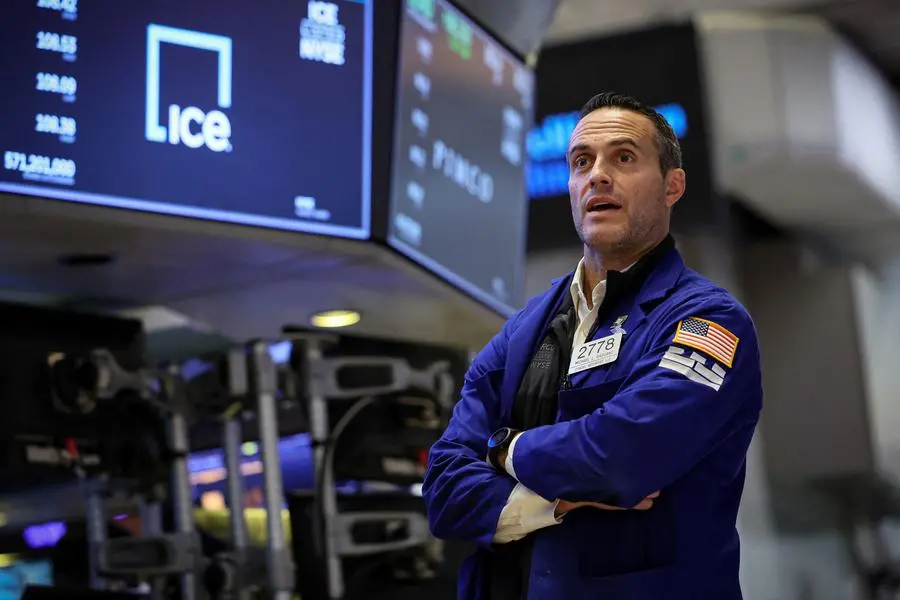PHOTO
World stocks were on track for their longest losing streak in two years on Thursday as the sight of oil prices nearing $100 a barrel compounded concerns about persistently high global interest rates.
There was brief respite from the dollar's strength in currency markets, but it was Wednesday's big drop in U.S. crude stocks that heightened nerves about another supply-side shock just when the global economy needs it least.
U.S. crude had hit $95 a barrel for the first time since August 2022 and while both it and $97 Brent prices eased fractionally in London trading they were 30% higher than at the end of June.
Europe's oil and gas stocks were up 0.5% and close to their highest since 2014, whereas the prospect of higher energy costs and sticky inflation piled more pressure on bond markets.
Ten-year U.S. Treasury yields, which are the benchmark of global borrowing costs, were above 4.6% for the first time since 2007 having started September at 4%.
Triple-A Germany's 2.93% yields hit their highest in 12 years before news that inflation there had slowed, while Wednesday's announcement that Italy's budget deficit is now widening again pushed its 2-year yields briefly to a 11-year high.
"What we have got is a beautiful inflection point," Mizuho's Head of Global Macro Strategies Trading, Peter Chatwell, said, explaining that markets were now sensing that both economic growth and inflation could stay strong next year.
"The repricing is applying some stress to credit spreads as well as other things," Chatwell said. "If the higher rate environment persists it is potentially much more difficult to keep debt levels stable."
Traders were also watching U.S. lawmakers' efforts to avoid a government shutdown in Washington.
With European stocks in and out of the red and U.S. S&P 500 futures barely budged, MSCI's main global equities index which tracks 47 countries was in danger of a 10th straight daily fall, a losing streak not seen since 2021.
MSCI's index of Asia-Pacific shares outside Japan had ended near a 10-month trough, while Japan's Nikkei fell 1.5% as investors there readied for the end of the quarter and offloaded stocks that went ex-dividend.
The strong dollar has the Japanese yen within a whisker of 150-per-dollar, seen as a level likely to provoke an official response or intervention.
Dollar/yen was hovering around 149.40 on Thursday. The euro was licking its wounds too at $1.0535, having dropped to a nine-month low of $1.0488 in the previous session.
Institutes in Germany predicted its economy will shrink 0.6% this year and Spanish data showed headline inflation rose to 3.5% this month due to the soaring cost of energy.
Focus in the U.S. session will be on the final reading of second-quarter GDP and weekly jobless claims data to gauge the strength of the U.S. labor market. A number of central bankers are also putting in an appearance, most notably Federal Reserve Chair Jerome Powell at 2000 GMT.
CHINA BREAK
Chinese markets had limped toward a long holiday that begins on Friday. The break may be a welcome one for traders after weeks of bad news in the country's struggling property sector.
Shares in the poster child of the troubles, China Evergrande , had to be suspended in Hong Kong after a report that chairman Hui Ka Yan was under police watch. The stock, once worth more than HK$30, is now near HK$0.30.
Investors worry a liquidation would further damage the tanking property market and stifle tentative green shoots elsewhere in the Chinese economy.
"China's property-sector stress will continue to pose cross-sector credit risks in the near term," said Fitch Ratings on Thursday. "The government's modest policy easing to date is unlikely to drive a sharp turnaround in homebuyers' sentiment."
The Hang Seng fell 1% and is close to a 10-month low. The mainland CSI300 fell 0.2%.
China's yuan is also coming under pressure and only a very strong fixing of its trading band has held off sellers. The yuan last changed hands at 7.3057 per dollar, not far from the weaker extremity of its trading band.
Higher energy prices helped the Australian dollar to stabilise at $0.6378.
Gold, though, was heading for its worst week since February as the rise in Treasury yields drives investors out of the precious metal, which pays no yield. It nursed losses at $1,875 an ounce.
(Additional reporting by Tom Westbrook in Singapore Editing by Ros Russell and Mark Potter)






















